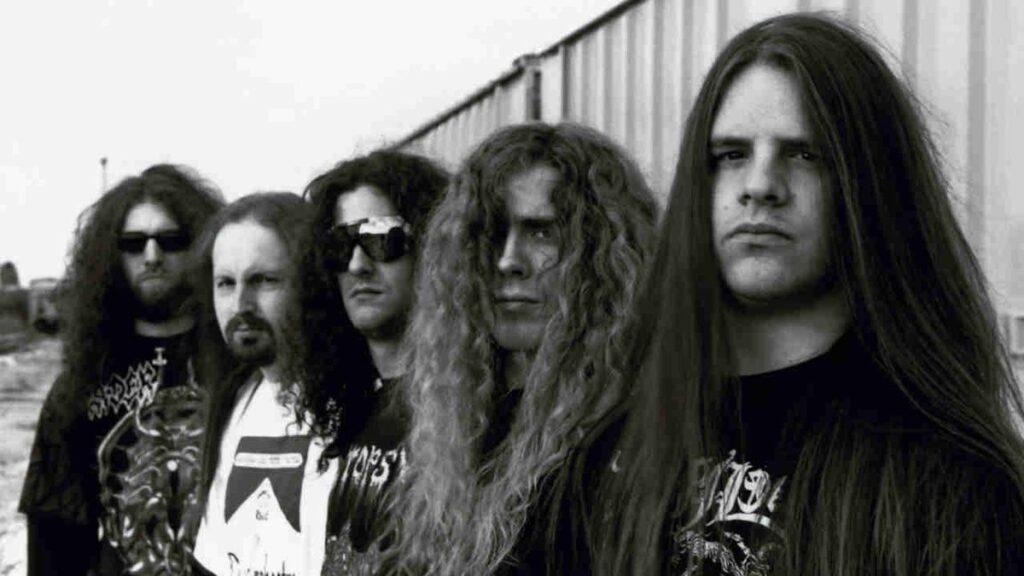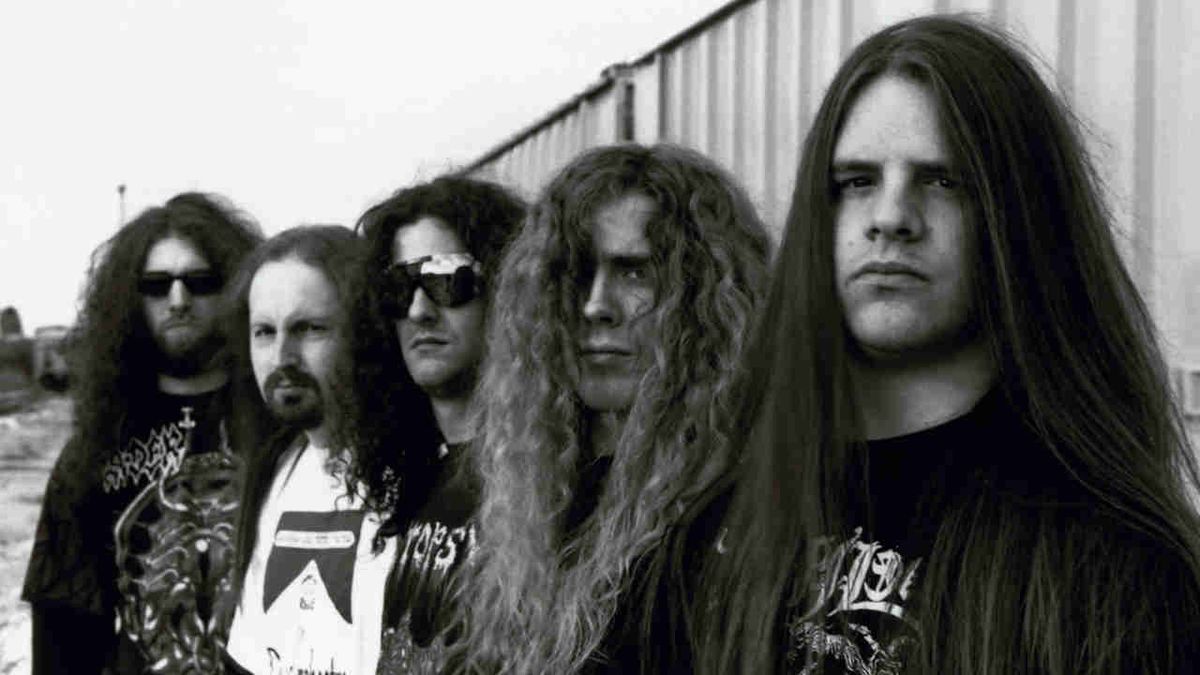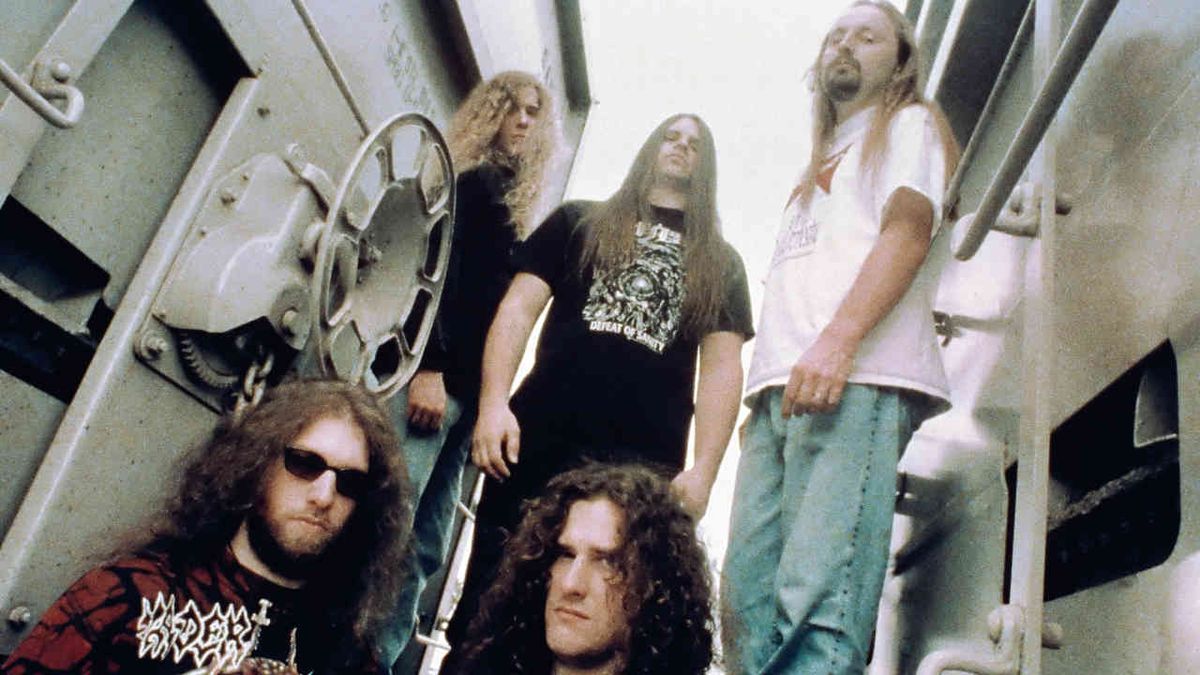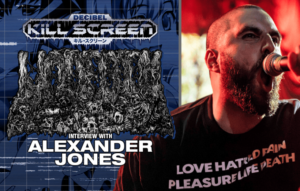Cannibal Corpse: the story of the Vile album

SUBSCRIBE TONIGHT prime video
Cannibal Corpse may have garnered notoriety with original singer Chris Barnes, but it was his departure and the arrival of replacement George ‘Corpsegrinder’ Fisher for 1996’s Vile album that helped turn them into the biggest-selling death metal band of all time. In 2007, drummer Paul Mazurkiewicz looked back on the making of the album that put them in the US charts for the very first time.
Cannibal Corpse have never shied away from controversy thanks to their unrelentingly graphic approach. But these Buffalo, New York heavyweights have also served up some of the most vicious, brutal noise ever conceived, elevating them to death metal’s elite alongside Death, Morbid Angel, Deicide and Obituary.
Formed in 1988 by vocalist Chris Barnes, guitarists Bob Rusay and Jack Owen, bassist Alex Webster and drummer Paul Mazurkiewicz, they hit the underground hard with 1990 debut Eaten Back To Life. Butchered At Birth (1991) and Tomb Of The Mutilated (’93) continued the shock-and-gore tactics, and even the loss of Rusay didn’t halt the menace. With Rob Barrett in his place, the band roared on with The Bleeding in 1994. That same year, comedian Jim Carrey insisted they perform their song Hammer Smashed Face in mega successful movie Ace Ventura – Pet Detective.
Unsurprisingly, their no-holds-barred lyrics were getting unwanted, though unsurprising attention from the powers that be. Viscerally vivid numbers such as Entrails Ripped From A Virgin’s Cunt and Meat Hook Sodomy were criticised by Republican Senator Bob Dole in 1995, who claimed they violated human decency.
Cannibal Corpse rode out the external controversy, but internal problems were brewing as they began work on the follow-up to The Bleeding.
“We started off the next album with Barnes, and we all knew this was gonna be an important time for us,” says Paul Mazurkiewicz. “The Bleeding had begun a process of change in the band. We were developing musically, and the aim was to really take things to the next level. I believe this was obvious with the music that the four of us were coming up with at the time.”

The problem was Chris Barnes wasn‘t on the same page as the rest of them. “I think over a period of time he saw Cannibal Corpse as being his property, and he would do things in his way, never listening to anyone else and never yielding from his viewpoint,” says Mazurkiewicz. “He had a way of doing things, and that had worked – until then. But, quite honestly, when we heard what Chris was doing vocally on the new record, all of us knew we had a serious problem on our hands…”
At this point, the album had the working title of Created To Kill, and seven tracks were recorded with Barnes, before the decision was taken to can them – and him. But it wasn’t just the vocals that were the problem.
“The lyrics Chris was coming up with just didn’t seem to fit where the rest of us were taking the songs,” says Mazurkiewicz. “He was stuck in the old ways, whereas we wanted to progress. We did try to help him out, but Barnes was so stubborn that it was very tough. I remember one of the last conversations that I had with him outside the studio…I said we wanted to be as supportive of him as possible, and he admitted that he was struggling to step up a gear. At that point, we were all committed to getting him through, and making this work.
“The final straw, though, came when we heard what he’d done on Devoured By Vermin. This was always gonna be the opening song on the album. As such, it had to have an immediate impact, to make a statement about what was to come. But Chris hadn’t risen to the challenge. After hearing what he’d done, Alex Webster bluntly turned on him and said, ‘I’m gonna completely re-write the lyrics.’ That finished Chris. He was devastated. He’d lost control.”
If Cannibal Corpse were still agonising over what to do next, then Barnes’ announcement that he was leaving the studio and going on tour with his other band, Six Feet Under, gave his remaining bandmates a chance to assess the situation, and make the inevitable move.
“We just knew Chris had to go – that was the only thing to do. So, we phoned him when he was on the road and said, ‘Dude, you’re out.’ It was as simple as that. None of us could live with what he’d done in the studio, and we knew there was no way he’d change. The problem we had was where to go next.”

For Mazurkiewicz and the rest of the band, there was only one candidate who could replace Barnes: George ‘Corpsegrinder’ Fisher from Florida technical death metalheads Monstrosity.
“Did we have a short list of possible replacements? Yes, and it had one name on it. George was the only person we ever considered. We believed he could do what we wanted. If he had declined, or hadn’t have worked out, I’m not sure what would have happened. It may have been the end of Cannibal Corpse. It was as serious as that.”
Fortunately, Fisher agreed to help salvage the album, and immediately tuned in to the band’s renewed sense of creativity. His vocals seemed to feed off the dynamism, freshness and vitality that lit up the music. But it was a rush to meet the deadlines.
“We spent a few weeks working in the studio with George,” says Mazurkiewicz. “But he didn’t contribute much to the songs at all, at least not lyrically – there wasn’t the time. Alex and I had both had previous experience in writing lyrics, so the challenge fell to us to get everything sorted on that front. We were flying by the seat of our pants, but got the job done. We both enjoyed getting involved with that side of the songs. Chris had never previously allowed anyone else near the lyrics.”
But finishing the record was only the start of the battle. The band now had to convince their label, Metal Blade, and the fans that changing vocalists in virtual mid-stream was the right move.
Mazurkiewicz: “I’ll admit that Brian Slagel, the head of the record company, wasn’t at all pleased. That was understandable. For any band to fire their vocalist is a really risky step. But we had complete faith in what George had done, and thankfully the fans’ reaction was almost totally positive.”
Renamed Vile, the record was released in May, 1996, and became the band’s first ever chart success in America, reaching the lofty heights of number 151 – an impressive feat for a gore-inspired death metal record.
“It may have been partly due to the leg work we’d done with The Bleeding, and also because we’d matured as a band as well. But it was a great moment when Vile charted. Here was proof that people had embraced what we were doing, in bigger numbers than ever. And it was a vindication of our decision to bring in the new man.”

However, the spectre of Barnes didn’t just fade away. When the band re-designed their logo, rumours swirled that it was because their former bandmate actually owned the rights to the original. Not true, according to Mazurkiewicz.
“No, he didn’t legally own it,” says the drummer. “But Chris did draw the thing in the first place. We needed a logo when the band started out, and he came up with something suitable. But once we’d fired him, then he started asking for payment on all CDs and merchandise we sold that carried his logo. Therefore, we decided to come up with a new one for the Vile release, which also marked a new era for us. So, it really did the job on two levels.”
Not for the first time, the graphic gore portrayed on a Cannibal Corpse album sleeve also caused a major problem. This time, it was a rotting penis in the drawing – one inspired by the song Mummified In Barbed Wire – that generated controversy. It wasn’t exactly a surprise for the band.
“We did hit problems in Germany with this one, as had happened before on Butchered At Birth and Tomb Of The Mutilated. What they did in the end was use a close up of the head and shoulders of the mummy, which solved the problem. What we learnt from this, though, was to do two covers: one brutal and one censored. Otherwise, you run the risk of the label butchering the original without consulting you first.”
Vile didn’t just mark the beginning of a new chapter for Cannibal Corpse, it revitalised them. By 1998’s Gallery Of Suicide, Corpsegrinder was properly settled into his role as frontman. They continued to release albums, defying both the downturn in the death metal scene’s fortunes and multiple line-up changes. Mazurkiewicz and Webster remain the only original members, though Corpsegrinder continues to front the band and Vile-era guitarist Rob Barrett subsequently returned to the band in 2005 after leaving eight years earlier.
In 2003, curious fans finally got a chance to hear the songs from the ill-fated pre-Vile sessions that saw the departure of original singer Chris Barnes. Seven demo tracks featuring Barnes’ vocals were included on that year’s 15 Year Killing Spree box set, including four that would be re-recorded by Corpsegrinder for Vile, namely Devoured By Vermin, Mummified In Barbed Wire, Bloodlands and Puncture Wound Massacre.
“Virtually everyone who’s heard these has the same reaction: ‘No wonder you had to get rid of Barnes,’” says Mazurkiewicz. “I’ve yet to come across anyone who rates them as better than what’s on Vile. We didn’t put them on to embarrass Chris at all. But they are part of our history, and have become quite celebrated over the years. It was a chance for people to make up their own minds.
The seven songs almost never saw the light of day at all. The master tapes for the Barnes sessions were wiped. “I’m not sure why that occurred,” says Mazurkiewicz. “So we had to take the recordings off cassettes. All five members of the band at the time, and our co-producer Scott Burns, had a cassette, and that’s what we used. This band tries to keep everything we do, because it’s part of what we are – no matter how awful we might feel it to be.”
So, how does the drummer view Vile itself in hindsight?
“I think it may well deserve to be regarded as our most crucial record,” he says. “It was a turning point for us, when we ditched so much of our past and went towards an uncertain future. It could have backfired badly. But thankfully it worked. Without Vile and everything that happened while we did it, we might never have survived into the 21st Century.”
Originally published in Metal Hammer issue 163. Updated in August 2024
SUBSCRIBE TONIGHT prime video
Source link





